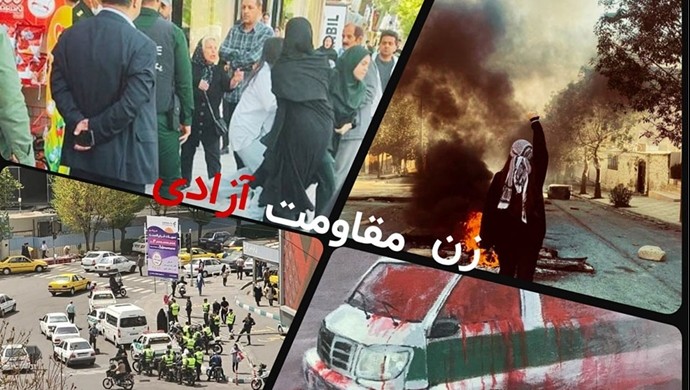The clerical regime, which only survives by creating fear and terror and by capturing and imprisoning people, has initiated its first public wave of suppression in the new Persian year.
On April 10, Iranian regime supreme leader Ali Khamenei issued the order of suppression under the pretext of combating “the breaking of religious” for the enforcers of “encouraging virtue and preventing vice,” and then the commander of Tehran’s suppressive law enforcement announced that “the plan for hijab and chastity will be pursued more seriously in all streets and public places starting from April 13.”
The preparation for this wave of suppression was orchestrated by the regime’s Friday Prayer leaders, and they had started threatening women since the Nowruz holidays. One of them labeled “improper veiling” as an “intellectual war, a complex and mysterious combination of efforts” by the enemy, while another promised to “manage” any form of “violation of sanctity,” and yet another considered the “exposure of hijab” as a “crime” and threatened to act against it.
Just as the regime always has many innocent people at its disposal for execution and, depending on the volatile conditions of the country, uses some of them to instill fear and terror in society, the issue of hijab is also one of the excuses used by the clerical regime to suffocate society.
While threats, intimidation, and internal suppression are inherent and fundamental pillars of the clerical regime, it should not be considered as a static and linear phenomenon, moving uniformly along a straight path. Rather, suffocation, fear, and terror within this regime have always had a fluctuating and oscillating nature, rising, and falling with the political conditions and social protests.
In this perspective, it is necessary to find reasons or factors for the new wave of systematic suppression led by Khamenei and his associates, which requires examining the critical situation of the regime in the new year. In this year, Khamenei carries the heavy burden of not only the existing crises but also the “worst event of the past year,” which is the mass boycott of the parliamentary elections in March. His forces still consider his election defeat to be more significant than an earthquake, arguing that the damages caused by earthquake can be repaired. However, when political and social credibility is lost among the people, it leads to even greater damage and more negative consequences.
Therefore, Khamenei has started this year with consecutive political rifts and a series of seismic events, including ongoing protest movements across the country. In the regional context, the situation has reached a critical point, and with the shift of attention towards Iran’s regime as the head of the snake, the era of hitting and running has come to an end.
The economic and social crises have intensified compared to last year, and skyrocketing prices continue to push the people into poverty and misery. As a result, dissatisfaction and protests have erupted among various segments of society, and hardly a day goes by without street protests.
Certainly, among all the misfortunes of Khamenei, social dissatisfaction is the worst because it can lead to the next uprising, and it is his primary and urgent concern. In every gathering, protest, and outcry, he sees the nightmare of an uprising. As a result, he has no solution other than suppression, and the suppression of women is the widest and most accessible form of social suppression that he has put on his agenda. Cunningly, he tries to portray this suppression as protecting “religion,” “promoting virtue,” “Islam,” “the sanctity of faith,” and so on. In this arena as well, the PMOI Resistance Units continuously remind us of the main front, which is the people’s battle against the integrity of the clerical regime, with the slogan of “Woman, Resistance, and Freedom.”
Amid all this, Khamenei has witnessed the bitter experience of suppressing women during the 2022 uprising, and he keeps an eye on it and remains cautious. He has also witnessed the selflessness and leadership of Iranian girls and women and knows that the same pretext for suppression can become the starting point and spark of protests. Therefore, he walks a tightrope, unable to engage in complete and overt suppression due to the uncertainties and risks involved.
It is indeed strange and instructive, from a historical perspective that in these same days last year, the head of Law Enforcement Force, Ahmad-Reza Radan threatened women by declaring war on them.
On April 7, the IRGC Quds Force–affiliated Tasnim News Agency quoted him as saying, “My colleagues will enter the public streets, vehicles, and places on April 14, as announced in these three areas.”
Indeed, despite all the tricks, such as seizing cars, sealing cafes, harassing women for their hijabs, and engaging in multi-million-dollar extortions, the regime did not achieve any success. Instead, during the year, it embarked on regional warmongering, only to suffer defeats in both its warmongering and the election.





